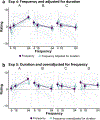More frequent, shorter trials enhance acquisition in a training session: There is a free lunch!
- PMID: 34570562
- PMCID: PMC8897207
- DOI: 10.1037/xge0000910
More frequent, shorter trials enhance acquisition in a training session: There is a free lunch!
Abstract
The strength of the learned relation between two events, a model for causal perception, has been found to depend on their overall statistical relation, and might be expected to be related to both training trial frequency and trial duration. We report five experiments using a rapid-trial streaming procedure containing Event 1-Event 2 pairings (A trials), Event 1-alone (B trials), Event 2-alone (C trials), and neither event (D trials), in which trial frequencies and durations were independently varied. Judgements of association increased with increasing frequencies of A trials and decreased with increasing frequencies of both B and C trials but showed little effect of frequency of D trials. Across five experiments, a weak but often significant effect of trial duration was also detected, which was always in the same direction as trial frequency. Thus, both frequency and duration of trials influenced learning, but frequency had decidedly stronger effects. Importantly, the benefit of more trials greatly outweighed the observed reduction in effect size caused by a proportional decrease in trial duration. In experiment 5, more trials of proportionately shorter duration enhanced effects on contingency judgments despite a shortening of the training session. We consider the observed 'frequency advantage' with respect to both frequentist models of learning and models based on information. (PsycInfo Database Record (c) 2022 APA, all rights reserved).
Figures






References
-
- Allan LG (1980). A note on measurement of contingency between two binary variables in judgment tasks. Bulletin of the Psychonomic Society, 15(3), 147–149.
-
- Allan LG, & Jenkins HM (1983). The effect of representations of binary variables on judgment of influence. Learning and Motivation, 14(4), 381–405.
-
- Baker AG, Murphy RA, & Vallee-Tourangeau F (1996). Associative and normative models of causal induction: Reacting to versus understanding cause. In Shanks DR, Holyoak KJ, & Medin DL (Eds.), The psychology of learning and motivation (Vol. 34, pp. 1–45). New York: Academic Press. 10.1016/S0079-7421(08)60557-5 - DOI

